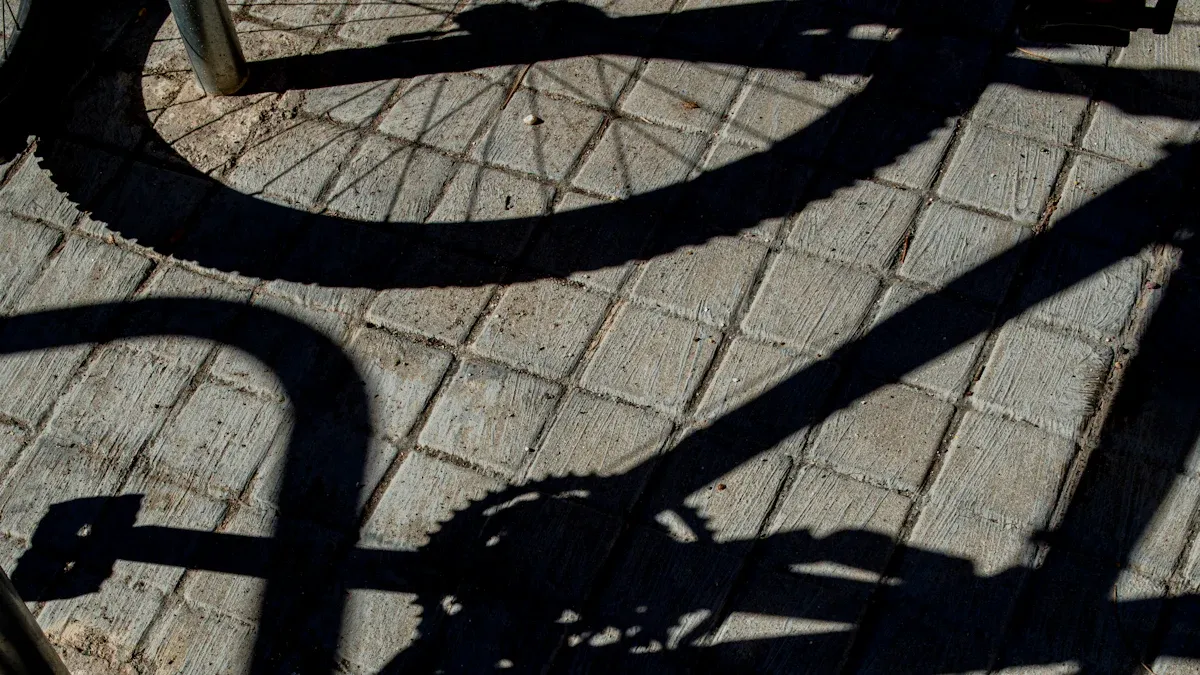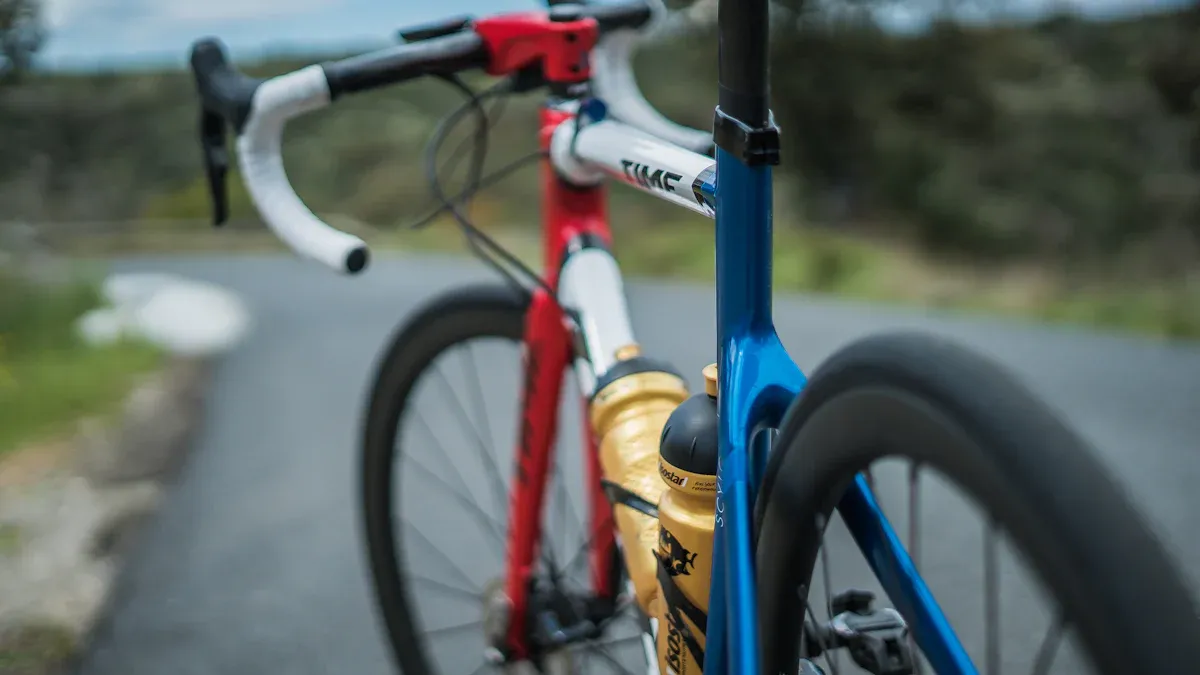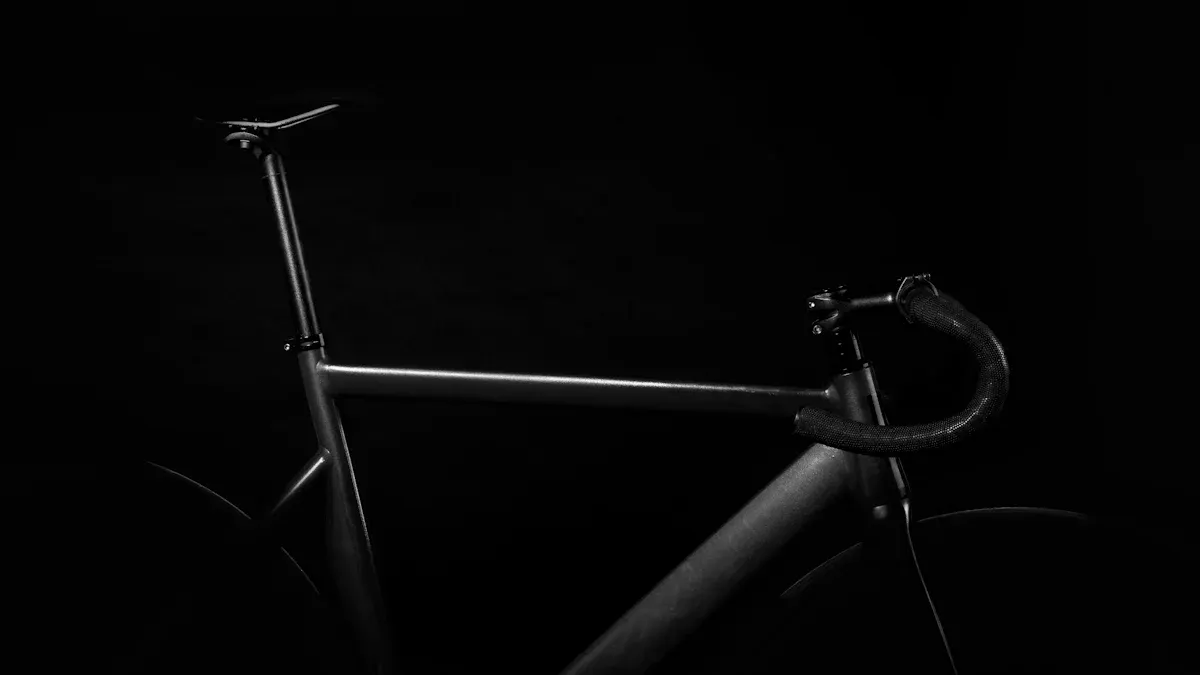
When you get on your bike, the road bike frame shapes matter a lot. The right bike frame can change how much you enjoy riding. It can make you more comfortable and help you ride better. For example, road cyclists usually like seat tube angles (STA) between 72° and 76°. These angles help them race faster. This blog will help you find a bike shape that matches your riding style. This way, you can enjoy every pedal stroke.
Key Takeaways
Learn about bike shape, especially stack and reach. This helps you ride better and feel more comfortable.
Pick the right bike shape—race, endurance, or all-road. Choose based on how you like to ride.
Make your bike fit better by changing saddle height, position, and handlebar height. This makes your ride more comfy.
Think about getting help from bike fitting experts. They can make changes that improve comfort and lower injury chances.
Stay away from common mistakes. Don’t ignore frame size. Don’t think bike fit will fix all comfort problems.
Understanding Bike Geometry

When you think about bike geometry, two main measurements are important: stack and reach. These measurements affect how your bike feels and works. Let’s explain them.
Key Measurements
Here’s a quick look at some key bike geometry measurements:
Measurement | Definition |
|---|---|
Stack | This is the height from the bottom bracket to the top of the head tube. It shows frame height. |
Reach | This is the distance from the bottom bracket to the top-centre of the head tube. It shows frame length. |
Head Tube Angle | This is the angle of the head tube to the ground. It affects how hard it is to steer and how stable the bike is. |
Head Tube Length | This is the height from the bottom to the top of the head tube. It affects how you sit on the bike. |
Fork Rake/Offset | This is how much the fork is off from the line going down from the fork steerer tube to the ground. It affects how fast you steer. |
Trail | This is a mix of head tube angle and fork rake. It affects how the bike handles. |
Seat Tube Angle | This is the angle of the seat tube compared to the ground. It affects how you sit and your comfort. |
Bottom Bracket Drop | This is the distance from the ground to the middle of the bottom bracket. It shows how high the bike is. |
Knowing these measurements helps you pick the right road bike frame shapes for you.
Stack and Reach Explained
Stack and reach are very important because they change your riding position and comfort.
Stack shows how high the handlebars are compared to the bottom bracket. A taller stack means you sit more upright. This can be more comfy for long rides.
Reach shows how far the handlebars are from the bottom bracket. A longer reach can make you lean forward more. This is good for speed but might hurt after a while.
Let’s see how different bike models compare in stack and reach:
Bike Model | Stack (mm) | Reach (mm) | Riding Position Type | Comfort Level |
|---|---|---|---|---|
Specialized Tarmac | 565 | 395 | Aggressive | Moderate discomfort |
Specialized Roubaix | 605 | 384 | Upright | High comfort |
Trek Madone | 563 | 391 | Aggressive | Moderate discomfort |
Trek Domane | 591 | 377 | Upright | High comfort |
As you can see, stack and reach measurements change between models. This change affects how you feel on the bike. If you want a more relaxed ride, find a bike with a higher stack and shorter reach. If speed is your goal, a lower stack and longer reach might be better.
Tip: Always think about your body size when picking a bike. Matching the bike’s shape to your body can make you more comfortable and help you ride better. For example, if your legs are longer, a bike with a higher stack might work better for you.
Bike Geometry Types

Choosing the right bike is important. Knowing the different geometry types can change how you ride. Let’s look at the three main types: race geometry, endurance geometry, and all-road geometry.
Race Geometry
Race geometry is all about speed. Bikes with this geometry have a lower and longer frame. This helps you get into a more aggressive riding position. This position helps you transfer power better and respond quickly. It’s great for competitive cyclists. But, it can be uncomfortable on long rides. The stiff, aerodynamic tubes make sure every pedal stroke goes fast. If you want to race or push yourself, a bike with race geometry is a good choice.
Endurance Geometry
Endurance geometry is very different from race geometry. It focuses on comfort instead of speed. This makes it perfect for long rides. Here’s a quick look at the two geometries:
Geometry Type | Top Tube Length | Head Tube Length | Riding Position |
|---|---|---|---|
Race | Long | Short | Lower, aerodynamic |
Endurance | Short | Long | More upright |
Endurance bikes have a shorter top tube and a longer head tube. This design lets you sit more upright. It reduces strain on your back and neck. If you like long rides or casual cycling, an endurance bike will keep you comfy while you ride.
All-Road Geometry
All-road geometry mixes the best features of both types. It gives you a relaxed riding position while still performing well on different surfaces. Here are some key traits of all-road bikes:
Shorter chainstays: This makes the bike more agile and quick to handle, especially in tight turns.
Larger bottom bracket drop: This lowers the center of gravity, making it more stable on mixed terrain.
Slacker head tube angle: This increases stability on rough surfaces, giving you a more comfortable ride.
All-road bikes are flexible. They let you ride on both paved roads and gravel paths. They balance comfort and performance, making them a great choice for riders who want to explore different terrains.
Choosing the right bike geometry can really improve your riding experience. Whether you’re racing, going on long rides, or exploring mixed surfaces, knowing these geometries will help you find the best road bike frame shape for you.
Impact of Geometry on Comfort
When you ride, your bike’s geometry is very important for comfort. It affects how the bike handles and how stable it feels on different surfaces. Let’s look at how these things matter.
Handling and Stability
Handling and stability are key for a smooth ride. How your bike reacts to your movements can change your experience. Here are some important points to think about:
Head Tube Angle: A steeper head tube angle helps with quick handling. This means your bike will turn faster. But, it can feel shaky at high speeds. A slacker angle makes the bike more stable, especially on bumpy roads.
Fork Rake and Trail: These measurements work together to change how your bike feels. More trail usually means better stability. Less trail can make the bike feel quicker.
Wheelbase: A longer wheelbase often gives a more stable ride. This is helpful for gravel bikes on uneven ground.
Bottom Bracket Drop: A lower bottom bracket drop can help with stability. It lowers your center of gravity, making it easier to control the bike, especially in turns.
Knowing these parts helps you pick a bike that fits your riding style. If you want speed and quickness, choose a bike with a steeper head tube angle and shorter wheelbase. If comfort and stability are more important, go for a bike with a slacker angle and longer wheelbase.
Tip: Always try out different bikes to see how they feel. Your comfort and confidence on the bike are what really matter!
Real Person Geometry
Now, let’s discuss ‘real person’ geometry. This idea looks at how bike geometry can fit different body types and flexibility levels. Not everyone rides the same way or has the same abilities, so bike makers design bikes with different geometries for everyone.
Step-Through Frames: These frames are great for people with less flexibility or older riders. The low-step design reduces strain on hips and knees, making it easier to get on and off.
Adjustable Components: Many bikes have adjustable parts, so you can change your fit. This includes seat height, handlebar position, and stem length. Adjusting these can really improve your comfort.
Ergonomic Designs: Bikes made with comfort in mind can help stop discomfort and injuries. Studies show that a well-fitted bike can lower pain and boost performance. For example, a good bike fit can reduce riding pain for up to 120 days after the fit.
Here’s a quick look at some findings about bike geometry and comfort:
Findings | Description |
|---|---|
Pain Reduction | Riding pain and discomfort went down a lot after a good bike fit, lasting up to 120 days after. |
Injury Prevention | A better-adjusted bike can lessen the chance of injuries, improving overall comfort. |
Performance Improvement | Research shows that ergonomic changes can help both pro and amateur cyclists perform better. |
By knowing about ‘real person’ geometry, you can choose a bike that fits your body and makes your rides better. Remember, the right road bike frame shapes can really change how you feel while riding.
Customizing Road Bike Frame Shapes
If you want to enjoy your ride more, customizing your road bike frame shapes is important. Making a few changes can help you feel better and ride faster. Here are some tips to get you started.
Adjusting Components
Making the right changes to your bike parts can really help your fit and comfort. Here’s what to focus on:
Saddle Height: Change your saddle so your leg is mostly straight with a little bend when the pedal is down. This saves energy and reduces strain.
Saddle Position: Place the saddle so your knee is over the pedal spindle when the crank is at 3 o’clock. This helps you ride efficiently.
Handlebar Height: Change the handlebar height and reach to fit your torso length and arm position. This keeps your arms relaxed, which helps with comfort.
To make these changes, follow these steps:
Loosen the lever on the seat post to change the saddle height.
Move the saddle forward or backward to line up your knee with the pedal spindle.
Adjust the handlebar drop and width to match your body size.
These small changes can make your ride much better, especially on longer trips.
Professional Fitting
While making your own adjustments is good, think about getting professional fitting services. A professional bike fit can really boost your comfort and performance. Here’s how it works:
Step | Description |
|---|---|
Looks at your body shape, flexibility, and movement. | |
On-bike analysis | Involves riding to check your position and movements using tools like video. |
Key measurements | Includes saddle height, saddle position, handlebar reach, and cleat setup. |
Test riding and adjustments | Involves riding in the new position and making final tweaks. |
Post-fit feedback | Gives feedback on changes and may include a follow-up session. |
Studies show that personalized bike fitting helps recreational cyclists feel better and ride faster. Spending time on a custom-fit road bike frame can lead to long-term benefits, like less chance of injury and more fun while riding.
By taking time to adjust your bike and maybe getting professional help, you can make sure your road bike frame shapes fit your needs perfectly.
Choosing the right road bike frame shape can make a huge difference in your cycling experience. Remember these key points:
Understand bike geometry, including stack and reach.
Consider your riding style—whether you race, ride for endurance, or explore all roads.
Customize your fit for maximum comfort and performance.
Tip: Avoid common mistakes like not starting with the right frame size or thinking a bike fit will solve all your aches. Check out this table for more insights:
Mistake | Explanation |
|---|---|
You don’t start with the right frame size. | Proper bike fit involves more than just saddle height; it requires the right frame size for comfort and power transfer. A wrong size compromises fit. |
You change equipment without changing fit. | Altering components like handlebars or saddles can affect fit, and it’s crucial to consider these changes when adjusting your bike. |
You think a bike fit will fix all aches and pains. | Chronic pain may have multiple causes, and bike fit alone may not resolve these issues; other factors like core strength should be considered. |
By keeping these tips in mind, you can enhance your cycling journey and enjoy every ride! 🚴♂️
FAQ
What is bike geometry?
Bike geometry means the measurements and angles that shape a bike’s frame. These details affect how you sit, how comfy you feel, and how the bike handles. Knowing about geometry helps you pick a bike that suits your style and needs.
How do I know my frame size?
To find your frame size, measure your inseam and check the size chart from the maker. Most brands give tips based on your height and leg length. A good fit makes riding more comfortable and efficient.
Can I change my bike’s geometry?
You can change parts like the saddle and handlebars to make your fit and comfort better. But big changes to the frame usually mean you need a new bike. Always ask a pro if you’re not sure.
What’s the difference between stack and reach?
Stack is the vertical distance from the bottom bracket to the top of the head tube. Reach is the horizontal distance. Together, they help decide your riding position and comfort level on the bike.
Why is a professional bike fit important?
A professional bike fit makes your bike fit your body better, which improves comfort and performance. It helps stop injuries and makes your ride better. Spending money on a fit can really change your cycling experience.
See Also
Selecting The Ideal Aluminum Bike Frame For Your Riding Style
Finding The Perfect Bike Frame That Suits Your Requirements
Determining What Bike Frame Fits You Best
Choosing The Best Bike Frame Type For Optimal Comfort And Performance
